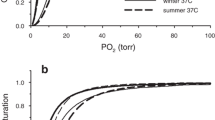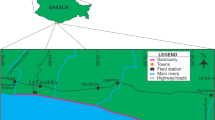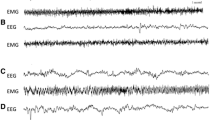Summary
-
1.
Blood pH,\(P_{{\text{CO}}_2 } \) and\(P_{O_2 } \) ofDipsosaurus dorsalis were measured during the day and at night. Lizards at constant body temperatures (25, 37°C) and lizards experiencing diurnal changes in body temperature similar to those in nature were studied.
-
2.
In lizards at constant body temperatures, blood pH was about 0.1 unit less and blood\(P_{{\text{CO}}_2 } \) was 4–7 Torr higher at night compared to day. Similar patterns were seen in lizards on natural thermal cycles (Figs. 1 and 2).
-
3.
Intracellular pH (pHi) of skeletal muscle, esophagus and liver was about 0.2 units lower at night than day but myocardial pHi was unchanged (Table 1).
-
4.
Reduction in breathing frequency, and thus a relative hypercapnia from hypoventilation was consistent with the nocturnal acidification of the blood and intracellular compartments (Fig. 3).
-
5.
Nocturnal acidification (CO2 retention) corresponds to periods of minimum metabolism. The possible impacts of diurnal shifts in hydrogen ion concentration on energy metabolism and metabolic regulation are discussed.
Similar content being viewed by others
References
Ackerman RA, White FN (1980) The effects of temperature on acid-base balance and ventilation in the marine iguana. Respir Physiol 39:133–139
Bickler PE (1981) Effects of temperature on acid-base balance and ventilation in desert iguanas. J Appl Physiol 51:451–460
Bickler PE (1982) Intracellular pH in lizardDipsosaurus dorsalis in relation to changing body temperatures. J Appl Physiol 53:1466–1472
Bickler PE (1984a) Effects of temperature on acid and base excretion in a lizard,Dipsosaurus dorsalis. J Comp Physiol B 154:97–104
Bickler (1984b) CO2 balance of a heterothermic rodent: comparison of sleep, torpor and awake states. Am J Physiol 246:R49–55
Cain SM (1970) Increased oxygen uptake with passive hyperventilation of dogs. J Appl Physiol 28:4–7
Datta AG, Abrams B, Sasaki T, van den Bergh JWO, Pontremoli S, Horecker BL (1974) The activation of rabbit muscle, liver and kidney fructose bisphosphatase by histidine and citrate. Arch Biochem Biophys 165:641–645
Hand SC, Somero GN (1983) Phosphofructokinase of the hibernatorCitellus beecheyi: temperature and pH regulation of activity via influences on the tetramer-dimer equilibrium. Physiol Zool 56:380–388
Harken AH (1976) Hydrogen ion concentration and oxygen uptake in an isolated canine hindlimb. J Appl Physiol 40:1–5
Hicks JW, Riedesel ML (1983) Diurnal ventilatory patterns in the garter snake.Thamnophis elegans. J Comp Physiol 149:503–510
Jackson DC (1978) Respiratory control in air-breathing ectotherms. In: Davies DG, Barnes CD (eds) Regulation of ventilation and gas exchange. Academic Press, New York, pp 93–120
Karetsky MS, Cain SM (1970) Effects of carbon dioxide on oxygen uptake during hyperventilation in normal man. J Appl Physiol 28:8–12
Lai YL, Atebury BA, Brown EB (1973) Mechanisms of cardiac muscle adjustment to hypercapnia. Respir Physiol 19:123–129
Magnussen G (1944) Studies on the respiration during sleep. HK Lewis, London
Stewart PA (1981) How to understand acid-base. Elsevier, New York
Strome DR, Clancey RL, Gonzales NG (1976) Myocardial CO2 buffering: role of transmembrane transport of H+ or HCO −3 ions. Am J Physiol 230:1037–1041
Truchot JP (1981) L'equilibre acido-basique extracellulaire et sa regulation dans divers groups animaux. J Physiol (Paris) 77:529–580
Reeves RB (1976) Temperature induced changes in blood acid-base status: pH and\(P_{{\text{CO}}_2 } \) in a binary buffer. J Appl Physiol 40:752–761
Wood SC, Johansen K, Glass ML, Hoyt RW (1981) Acid-base regulation during heating and cooling in the lizard,Varanus exanthematicus. J Appl Physiol 50:779–783
Author information
Authors and Affiliations
Rights and permissions
About this article
Cite this article
Bickler, P.E. Day-night variations in blood and intracellular pH in a lizard,Dipsosaurus dorsalis . J Comp Physiol B 156, 853–857 (1986). https://doi.org/10.1007/BF00694261
Accepted:
Issue Date:
DOI: https://doi.org/10.1007/BF00694261




